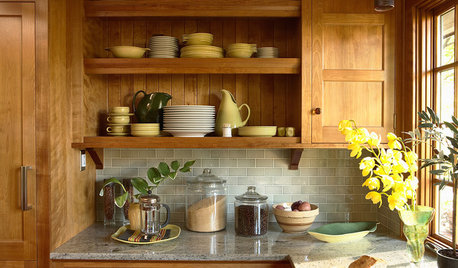hicans, selected hickories, black walnuts
cousinfloyd
11 years ago
Related Stories

REMODELING GUIDESYour Floors: Zebra, Tiger, and Teak Wood, Oh, My!
Get the Pros and Cons of Exotic Woods: Hickory, Cherry, Rosewood and More
Full Story
TRIMTrim Color Tips: Get Your White Trim Right
Set off wood tones, highlight architectural features, go minimalist ... white trim is anything but standard when you know how to use it
Full Story
HOUZZ TOURSMy Houzz: Color and Pattern Give a Newlyweds’ Home Zing
Starting from scratch, a British Columbia couple transforms their empty apartment with ready-made pieces and personal photos
Full Story
COLORColor of the Year: Off-White Is On Trend for 2016
See why four paint brands have chosen a shade of white as their hot hue for the new year
Full Story
MOST POPULARPros and Cons of 5 Popular Kitchen Flooring Materials
Which kitchen flooring is right for you? An expert gives us the rundown
Full Story
COLOR11 Terrific Paint Color Matches for Wood Details
Pair your wood trim and cabinets with the right shade of wall paint to bring out the beauty in both
Full Story
PETS5 Finishes Pets and Kids Can’t Destroy — and 5 to Avoid
Save your sanity and your decorating budget by choosing materials and surfaces that can stand up to abuse
Full Story
KITCHEN BACKSPLASHESHow to Choose a Backsplash for Your Granite Counters
If you’ve fallen for a gorgeous slab, pair it with a backsplash material that will show it at its best
Full Story
FURNITUREForever Furniture: A Buyer’s Guide to the Dining Table
There comes a time when a make-do piece of furniture won’t do. We give you a leg up on choosing the right table for you
Full Story
COLORCooking With Color: When to Use Gray in the Kitchen
Try out Trout or shake up some Martini Shaker gray for a neutral-based kitchen that whispers of sophistication
Full StoryMore Discussions








fabaceae_native
lucky_p
Related Professionals
Danbury Landscape Architects & Landscape Designers · East Rancho Dominguez Landscape Architects & Landscape Designers · McKinney Landscape Contractors · Stoughton Landscape Contractors · Concord Landscape Contractors · Cerritos Landscape Contractors · Cockeysville Landscape Contractors · Laguna Hills Landscape Contractors · Longview Landscape Contractors · Mahwah Landscape Contractors · Milford Mill Landscape Contractors · North Haven Landscape Contractors · North Lauderdale Landscape Contractors · Roseville Landscape Contractors · South Farmingdale Landscape Contractorsfruitnut Z7 4500ft SW TX
cousinfloydOriginal Author
spartan-apple
cousinfloydOriginal Author
fruitnut Z7 4500ft SW TX
lucky_p
lucky_p
marc5
spartan-apple
cousinfloydOriginal Author
cousinfloydOriginal Author
lucky_p
fusion_power
cousinfloydOriginal Author
cousinfloydOriginal Author
lucky_p
fusion_power
cousinfloydOriginal Author
wyatt_jones9